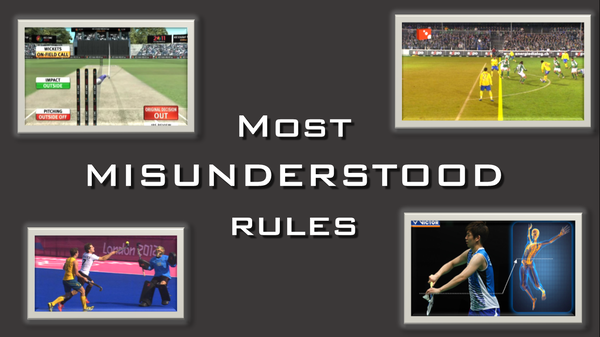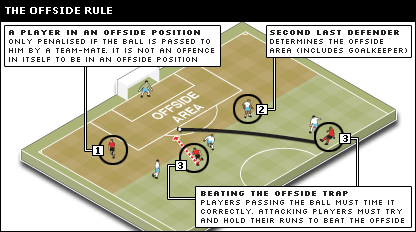
via Imago
Misunderstood Rules in Sports

via Imago
Misunderstood Rules in Sports
There are quite a few rules in the world of sport which often require a deep understanding and are a riddle to someone who’s not a regular sports follower. How often have you not been able to understand what the Duckworth/Lewis is, or what exactly is ‘offside’. We bring you some sports rules which will help you understand the sport(s) better, and make for a better viewing experience.

via Imago
Misunderstood Rules in Sports
ADVERTISEMENT
Article continues below this ad
Misunderstood Sports Rules
1. Offside, Football:
‘He was clearly offside, how could that goal be allowed. What is the linesman doing!’
You must heard have this at least once if you have watched football. At times, you must have wondered why a goal was not allowed when the player received a perfect pass and put the ball in, and then you are told that the player was in an ‘offside’ position.
A player is in an offside position when he or she is in the opponents’ half of the pitch and closer to the opponents’ goal line than both the ball and the second-to-last opponent (usually the last defensive player in front of the goalkeeper). Being in an offside position is not an offense in itself, a player must also be “actively involved in the play” in the opinion of the referee. When the offside offense occurs, the referee stops play and awards an indirect free kick to the defending team from the position of the offending player.

via Imago
The Offside rule explained.
2. The final set conundrum, Tennis:
Rafael Nadal won his first Wimbledon Championships Grand Slam when he defeated Roger Federer 6-4, 6-4, 6-7(7), 6-7(10), 9-7. But hey… how can the final set score read 9-7 when the highest set score possible is only 7-6?
Let’s explain you a bit about the 5 set rules which leave people a bit confused. So here we go. Usually when a set reads 6-6, a tie-breaker is played in which the player who wins a min of 7 points first with a lead of 2 points, wins the set. But when it comes to the Grand Slams like the Australian Open, French Open and The Wimbledon, NO tie-breaker is played in the final set. Rather the set goes on until there is a difference of 2 games in the set, both the set and the game consequently are awarded to the player who was ahead by two games. Because of this rule, American John Isner and Frenchman Nicolas Mahut played the longest match ever, lasting 11 hours 5 mins, in which the final set itself exceeded the previous record of the longest match ever, the set lasted 8 hours 11 minutes.

via Imago
Roger Federer and Rafael Nadal after the 2008 Wimbledon Championships Final
3. Dangerous Play, Hockey:
A lot about this rule is always unclear to the spectators and fans, because the majority of its application depends upon the judgement of the umpire. According to the current Rules of Hockey by the FIH, there are only two criteria for a dangerously played ball. The first is legitimate evasive action by an opponent (what constitutes legitimate evasive action is an umpiring judgment). The second is specific to the rule concerning a shot at goal at a penalty corner but is generally applied throughout the game and in all parts of the pitch: it is that a ball lifted above knee height and at an opponent who is within 5m of the ball is certainly dangerous. Also, the Players may not play or attempt to play at the ball above their shoulders unless trying to save a shot that could go into the goal, in which case they are permitted to stop the ball or deflect it safely away. But again, a lot about the enforcement of ‘dangerous play’ is upon the umpire.

via Imago
The ball being above the shoulder and hence quoted as ‘dangerous play’.
4. Leg Before Wicket (LBW), Cricket:
Perhaps no rule of cricket has created as much controversy and doubt as this one has. The primary reason for this is, there’s no evident proof of the dismissal, it purely depends upon the judgement and the prediction of the umpire. Other dismissals like being caught, run out, bowled out or hit wicket are absolutely clear and never raise a debate because everyone can see if the catch has been completed or not, or the bails have been dislodged or not. The basis of the law is that, following an appeal by the fielding side, the umpire may rule a batsman out lbw if the ball would have struck the wicket but was intercepted by any part of the batsman’s body except the hand holding his bat. The umpire’s decision will depend on a number of criteria, including where the ball pitched, whether the ball hit in line with the wickets and whether the batsman was offering a shot. The rule was introduced to negate the defensive and negative play by batsmen against spinners to protect getting out. With the introduction of Decision Review System, the rule has become even more complex for the people to understand.

via Imago
All the scenarios explaining LBW (Leg Before Wicket)
P.S. – Sachin Tendulkar was ruled out LBW while ducking when a Glenn McGrath Delivery hit his arm in the line of stumps.

via Imago
Sachin Tendulkar being given out LBW when hit on te shoulder.
5. DRS, F1:
The first thing which comes to our mind of DRS is BCCI’s stand against it. However, this is not the DRS we’re talking about. This DRS stands for Drag Reduction System which is related to F1 and was introduced in 2011. A lot of F1 fans get confused over what it is, and how it is an advantageous situation for drivers. It consists of an adjustable flap in the rear wing of the car, which when opened gives the car a speed advantage of 10-12km/h. It was introduced primarily to enable more overtaking. DRS can only be used in specific parts of the circuit during the race, which are called the DRS activation zones. To use DRS, a driver must be within a second gap of the driver ahead him. As soon as he comes in the activation zone and is within a second of the other driver, he may switch on the DRS to provide the additional speed gain. The DRS will automatically be disabled (resetting the rear wing flap to its original position) the first time the driver uses the brakes after activation.

6. Back Pass Rule, Football:
Did you know that there’s a rule in football that prevents the Goalkeeper from handling the ball? Surprising, isn’t it?
The Back Pass rule is one such rule. It prohibits the goalkeeper from handling the ball when a team-mate has deliberately “kicked” the ball to him, or handling the ball directly from a team-mate’s throw-in. The goalkeeper is still permitted to use his feet and other body parts to redirect the ball. Contrary to what the name suggests, the offence is not the ball being passed back, but the goalkeeper using his hands. An indirect free-kick is awarded to the opposing team from the spot where the keeper handles the ball. But in practice, it is rarely committed.
The offence is based on the occurrence of three events:
- The ball is kicked (played with the foot, not the knee, thigh, or shin) by a team-mate of the goalkeeper,
- This action is deemed by the referee to be deliberate, rather than a deflection or a miss-kick which is not intended for goalkeepers direction,
- The goalkeeper handles the ball directly (no intervening touch of play of the ball by anyone else). Handling the ball involves retrieving the ball or making a save with one or both hands.
The rule was brought into the game to neglect the deliberate defensive play used by the winning team in order to deny the other team a chance to score.

via Imago
The Goalkeeper can’t touch the ball with his hands when the ball is passed to him.
7. Service Rule, Badminton:
Most baffling for viewers of badminton would be the service fault even when the shuttle doesn’t hit the net. The service fault is called by the service judge in what seems to be the most crucial points and it leaves the players fuming and arguing. This is frequently seen in the doubles game but not as much in singles. The service rule says that:
- The racquet must be hitting the shuttle below the waist.
- The racquet head should pointing downwards when hitting the shuttle
- The racquet head should be below the handle when making contact.
In the doubles games, most players use the backhand serve and while doing so, occasionally violate the first requirement. This though is controversial, as the “waist” is relative and doesn’t have a definite mark. The 2nd rule might also be violated, with the racquet being held flat while making contact thought this occurs rarely. Discussions and debates are in progress on how to make this rule less controversial. But next time you see a service fault being called, you don’t have to feel lost anymore.

via Imago
The Badminton service explained.
There are other rules as well in various sports which make a viewer to put on their thinking caps on, but none of them are as badly misunderstood as these and generate the same amount of controversy. Hopefully, now you can get back to the sports freak in your group and probably have an argument when an incident regarding these 5 rules takes place.
8. Duckworth/Lewis Method:
ADVERTISEMENT
Article continues below this ad
Ask South African cricket fans about which rule they’d like to change in cricket, or perhaps even remove it, and Duckworth/Lewis and other rain rules will be their answer. No cricket fan, no matter for how long has he been following the game, can predict the D/L score and explain the rule accurately. Duckworth/Lewis was accepted because it was much better alternative than the rain rule which was earlier in place. Because of the Rain Rule, South Africa had to chase 22 runs off 1 ball, which before the rain interruption was 22 off 13 balls.
The Duckworth–Lewis method (often written as D/L method) is a mathematical formulation designed to calculate the target score for the team batting second in a limited overs cricket match interrupted by weather or other circumstances. It based on the principle that a team has two resources to score the runs; the no. of overs left and the wickets available. Since it’s a mathematical formulation, there is absolutely no consideration about the quality of batsmen, momentum of an innings, no. of overs left by which bowler etc, something which was terribly exposed in the semi-final between South Africa and New Zealand. There was no doubt about it in anyone’s mind, that had South Africa batted the complete 50 overs, they would have made a score in excess of 350. Not only were AB de Villers and Faf Du Plessis set, but the majority of the overs were to be thrown down by the weakest link in the Kiwi bowling line-up, that is, Corey Anderson.

via Imago
Scoreboard from the 1992 World Cup Semi Final between South Africa and England
When overs are lost, setting an adjusted target for the team batting second is not as simple as reducing the run target proportionally to the loss in overs, because a team with five wickets in hand and 10 overs to bat can be expected to play more aggressively than if they had 5 wickets and 25 overs remaining, and can consequently achieve a higher run rate.
ADVERTISEMENT
Article continues below this ad
It’s a myth that the target set by D/L calculation is always more than what the team batting first scores, in some cases, it can be lesser as well depending upon the overs and wickets used up, and the no. of wickets and overs left.
ADVERTISEMENT
ADVERTISEMENT
ADVERTISEMENT
ADVERTISEMENT

